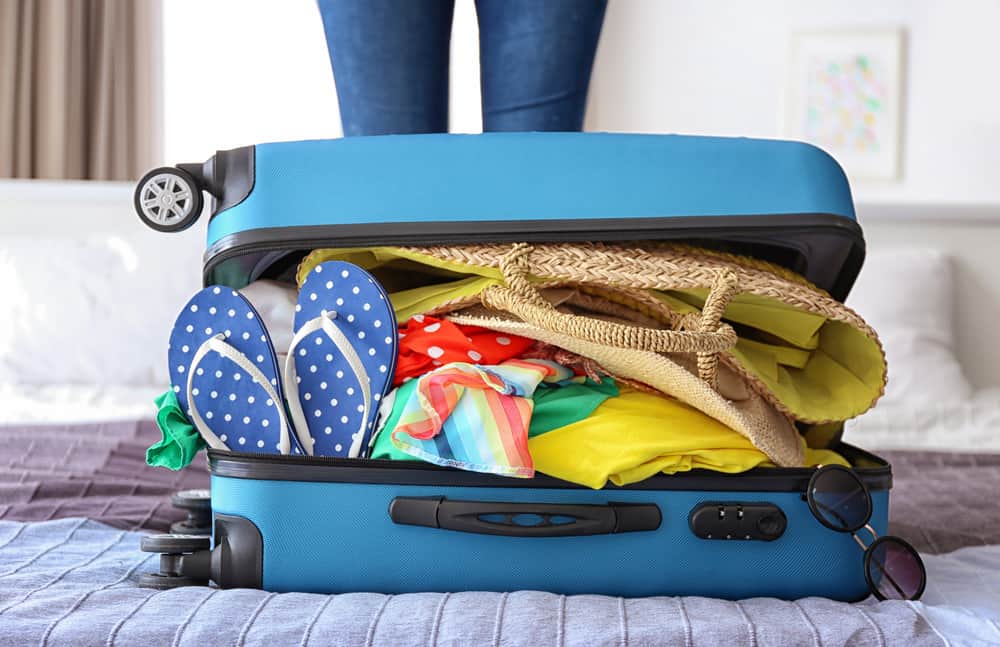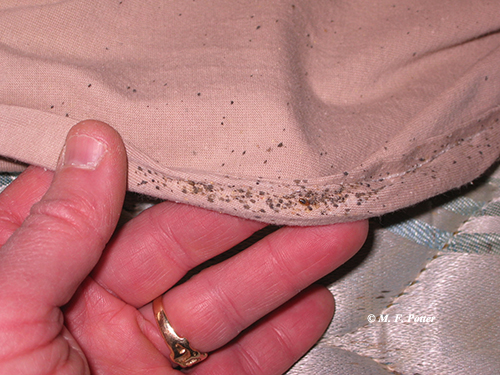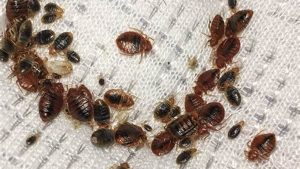Ever woken up with mysterious bites and wondered if those pesky bed bugs could chomp through your pajamas? You’re not alone! Let’s dive into the world of these tiny terrors and separate fact from fiction.
Understanding Bed Bugs: More Than Just Nighttime Nuisances

Bed bugs have been around since the time of dinosaurs, believe it or not! These resilient little critters have adapted to human environments over millennia. But what exactly are we dealing with?
Bed Bug Biology 101
Picture this: a reddish-brown insect about the size of an apple seed. That’s your typical adult bed bug. These nocturnal nuisances have a knack for hiding in the tiniest cracks and crevices, making them master hide-and-seek champions. Bed bugs are blood-sucking parasites, preferring human blood but not above snacking on other warm-blooded animals. They’re equipped with specialized mouthparts designed to pierce skin and suck blood, kind of like tiny, six-legged vampires.
Busting the Biting Myth
Now, here’s the million-dollar question: Can these little bloodsuckers bed bugs bite through your clothes? The short answer is no, they can’t. Bed bugs’ mouthparts simply aren’t strong enough to penetrate fabric. However, don’t break out the full-body pajamas just yet! While bed bugs can’t bite through clothes, they’re incredibly resourceful. These sneaky pests will crawl under loose-fitting clothes or target exposed skin. So, while your favorite flannel PJs might offer some protection, they’re not a foolproof defense. To effectively manage a bed bug problem, understanding How To Get Rid of Bed Bugs is crucial. There are several methods available that can help eliminate these pests from your home.
The Bed Bug Bite: More Than Just an Itch
Bed bug bites can be a real pain – literally! These bed bug bites often appear as small, red, itchy welts, typically in a line or cluster. But here’s the kicker: not everyone reacts to bed bug bites the same way. Some lucky folks might not show any signs at all, while others could experience intense itching or even allergic reactions. It’s like a bizarre bed bug lottery, and you never know what you’re going to get!
When Bed Bugs Attack
Bed bugs are nocturnal feeders, preferring to dine when their human hosts are fast asleep. They’re attracted to the carbon dioxide we exhale and our body heat. Talk about a creepy dinner date! These tiny vampires typically feed for about 5-10 minutes before scurrying back to their hiding spots. And here’s a fun fact: bed bugs can survive for months without a blood meal. Talk about resilience!
Protecting Yourself: More Than Just Buttoning Up

While bed bugs can’t bite through clothes, that doesn’t mean you should rely solely on your wardrobe for protection. These persistent pests require a multi-pronged approach to keep them at bay.
Inspection: Your First Line of Defense
Regular inspections are key to catching a bed bug infestation early. Keep an eagle eye out for signs like tiny brown spots on your mattress (bed bug poop – gross!) or small bloodstains on your sheets. Don’t forget to check those often-overlooked spots like behind picture frames or in the seams of your couch. Bed bugs are masters of hide-and-seek, so channel your inner detective!
Laundry: Your Secret Weapon
Bed bugs hate the heat, so your washing machine and dryer can be powerful allies. Wash and dry your bedding and clothes on the highest heat setting possible. It’s like a spa day for your linens and a doomsday for bed bugs! Remember, bed bugs can hitch a ride on your clothes, so be extra vigilant when traveling. Inspect your luggage and wash your travel clothes as soon as you get home. Better safe than sorry!
When Bed Bugs Strike: Don’t Panic, Take Action!
Despite your best efforts, sometimes bed bugs still manage to invade. Don’t worry, all is not lost! There are several steps you can take to reclaim your bed and your peace of mind.
DIY Bed Bug Battle

Start by thoroughly cleaning your living space. Vacuum every nook and cranny, paying special attention to your mattress and furniture. Seal up any cracks or crevices where bed bugs might be hiding. Consider investing in bed bug-proof encasements for your mattress and box spring. These create a barrier that avoid bed bugs can’t penetrate, effectively trapping any existing bugs and preventing new ones from setting up shop.
When to Call in the Pros
Sometimes, despite your best efforts, a bed bug infestation can become overwhelming. That’s when it’s time to call in the cavalry – professional pest control experts. These bug-busting pros have access to treatments and techniques that can effectively eliminate even stubborn bed bug infestations. Don’t be shy about seeking help; sometimes it’s the quickest path to a bed bug-free home.
The Bottom Line: Stay Vigilant, Sleep Tight
While bed bugs can’t bite through your clothes, they’re still persistent pests that require ongoing vigilance. Regular inspections, proper laundering, and quick action at the first sign of infestation are your best defenses. Remember, bed bugs don’t discriminate – they can infest even the cleanest homes. So don’t be embarrassed if you find yourself dealing with these nocturnal nuisances. With the right approach, you can send bed bugs packing and reclaim your peaceful nights. Sweet dreams, and don’t let the bed bugs bite!
Key Facts
| Category | Fact/Figure |
|---|---|
| Prevalence | – 20% of Americans have had a bed bug infestation or know someone who has |
| – 97% of pest control professionals have responded to bed bug complaints in the past year | |
| – Bed bug prevalence is 3 times higher in urban areas compared to rural areas | |
| Location | – Found in all 50 U.S. states |
| – Most common in single-family homes (91%), apartments/condos (89%), and hotels/motels (68%) | |
| – Also found in nursing homes, schools, offices, hospitals, and public transportation | |
| Biology | – Average lifespan: 6-12 months |
| – Female bed bugs lay 1-3 eggs per day, 200-500 in a lifetime | |
| – Can survive temperatures from 46°F to 113°F | |
| – Can ingest 7 times their body weight in blood | |
| Behavior | – Most active between midnight and 5 a.m. |
| – Feeding takes about 5-10 minutes | |
| – Can survive several months without a blood meal | |
| Human Impact | – 60% higher chance of bites on upper body compared to lower body |
| – 30% of people do not react to bed bug bites | |
| – Bites can become red or itchy up to two weeks after the fact | |
| Recent Trends | – 278% increase in bed bug instances in UK hotels (2022-2024) |
| – 5 times more bed bug cases in UK hotels in first 3 months of 2024 compared to same period in 2023 | |
| Top Affected Areas | – U.S. cities: Chicago, New York, Philadelphia, Cleveland |
| – U.S. states: Ohio, Pennsylvania |
FAQ: Can Bed Bugs Bite Through Clothes?
1. Can bed bugs bite through clothes?
No, bed bugs cannot bite through clothes. Their mouthparts are not strong enough to pierce through fabric.
2. Where do bed bugs usually bite?
Bed bugs typically bite exposed skin, such as the face, neck, arms, and legs. They seek out areas where the skin is directly accessible.
3. How can I protect myself from bed bug bites if they can’t bite through clothes?
Wearing long-sleeved shirts and pants made of thick fabric can help reduce the risk of bed bug bites. Additionally, tucking your shirt into your pants and your pants into your socks can create a barrier.
4. Do bed bugs prefer any specific type of fabric?
Bed bugs do not have a preference for specific types of fabric. They are attracted to the carbon dioxide and warmth emitted by the human body, not the type of clothing.
5. Can bed bugs crawl under my clothes to bite me?
Yes, bed bugs can crawl under loose clothing to reach your skin. Ensuring a snug fit of your clothes can help minimize this risk.
6. What should I do if I find bed bugs in my clothing?
If you find bed bugs in your clothing, immediately wash the affected items in hot water and dry them on the highest heat setting. This can effectively kill bed bugs and their eggs.
7. Can bed bugs hide in my clothes?
Yes, bed bugs can hide in clothing, especially if the clothes are left in infested areas. It’s important to keep your clothes off the floor and stored in sealed plastic bags or containers if you suspect an infestation.
8. Are there any special clothing treatments to prevent bed bug bites?
There are bed bug-proof encasements and sprays that can be used on clothing and bedding. However, the best prevention is to keep your living area clean and regularly inspect for signs of bed bugs.
9. What are the signs of bed bug bites?
Bed bug bites often appear as small, red, itchy welts on the skin. They are usually found in clusters or lines and may cause discomfort or allergic reactions in some individuals.
10. Can bed bugs transmit diseases through their bites?
Bed bugs are not known to transmit diseases. However, their bites can cause itching and discomfort, and excessive scratching may lead to secondary infections.
By understanding the behavior of bed bugs and taking preventive measures, you can reduce the risk of bites and manage any infestations effectively.


